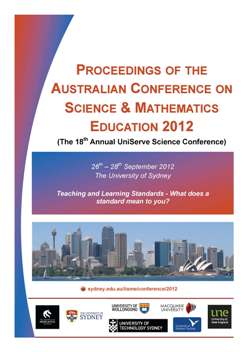Use of an online system for student responses in first year chemistry
Abstract
Although the benefits of clickers for monitoring student understanding during lectures are well-established (Gebru, Phelps, & Wulfsberg, 2012; Lin, Liu, & Chu, 2011; MacArthur & Jones, 2008; Patry, 2009; Smith, Wood, Krauter, & Knight, 2011), their cost makes them inaccessible in many Faculties. Recently, several websites have been launched that offer academics the ability to monitor student understanding in a similar way, using any mobile internet enabled device (phone, tablet, laptop computer). We have trialed the use of one such system with first semester chemistry students and the results are reported here. There were some technical difficulties to be overcome and the importance of these should not be understated; in a time-limited setting with a very large class, a system needs to run flawlessly in every session. Student feedback was largely positive in other respects, although a few felt that the use of expensive devices that not every student has access to, was inequitable. The trial was undertaken as an action learning project within the SaMnet framework (http://www.samnet.edu.au) and aimed to promote the use of student response systems among other academic staff. To this end, staff were invited to attend lectures, participate in the student response questions and provide feedback on the system. This feedback also indicated that technical ease of use and stability are critical factors to encourage uptake of the system. This and other aspects of adoption have been investigated in the United States (Emenike & Holme, 2012). In this poster, we propose mechanisms to improve uptake and to minimise inequity of access. REFRENCES Emenike, M. E., & Holme, T. A. (2012). Classroom response systems have not “crossed the chasm”: Estimating numbers of chemistry faculty who use clickers. Journal of Chemical Education, 89, 465-469. Gebru, M. T., Phelps, A. J., & Wulfsberg, G. (2012). Effect of clickers versus online homework on students’ long-term retention of general chemistry course material. Chemistry Education Research and Practice, online doi: 10.1039/c2rp20033c Lin, Y.-C., Liu, T.-C., & Chu, C.-C. (2011). Implementing clickers to assist learning in science lectures: The Clicker-Assisted Conceptual Change model. Australasian Journal of Educational Technology, 27, 979-996. MacArthur, J. R., & Jones, L. L. (2008). A review of literature reports of clickers applicable to college chemistry classrooms. Chemistry Education Research and Practice, 9, 187-195. Patry, M. (2009). Clickers in large classes: From student perceptions towards an understanding of best practices. International Journal for the Scholarship of Teaching and Learning, 3. Smith, M. K., Wood, W. B., Krauter, K., & Knight, J. K. (2011). Combining peer discussion with instructor explanation increases student learning from in-class concept questions. CBE - Life Sciences Education, 10, 55-63.Downloads
Published
2012-08-24
Issue
Section
Abstracts
